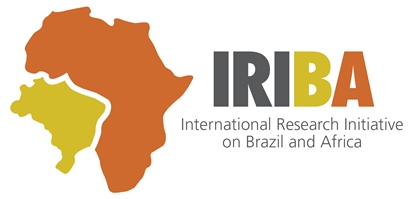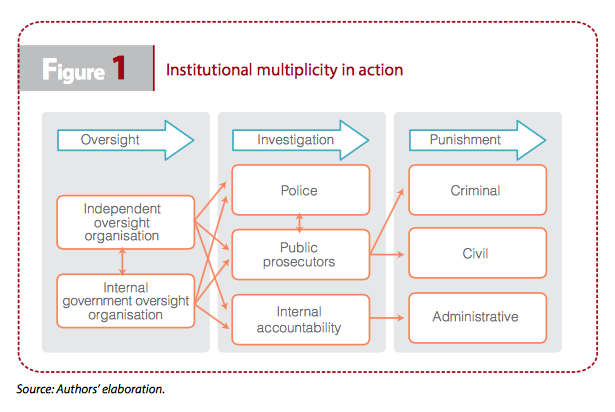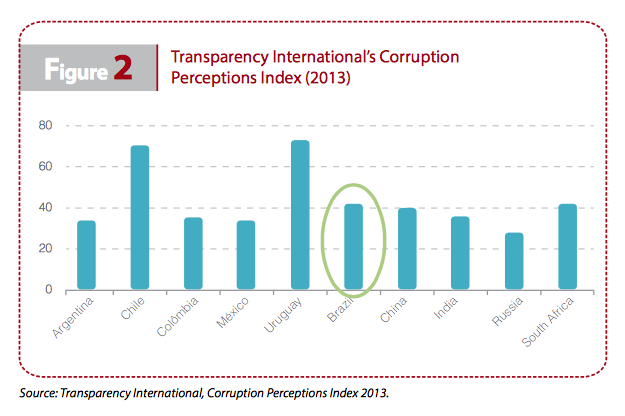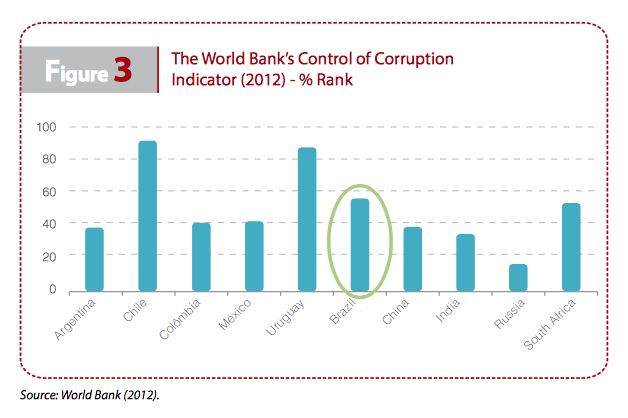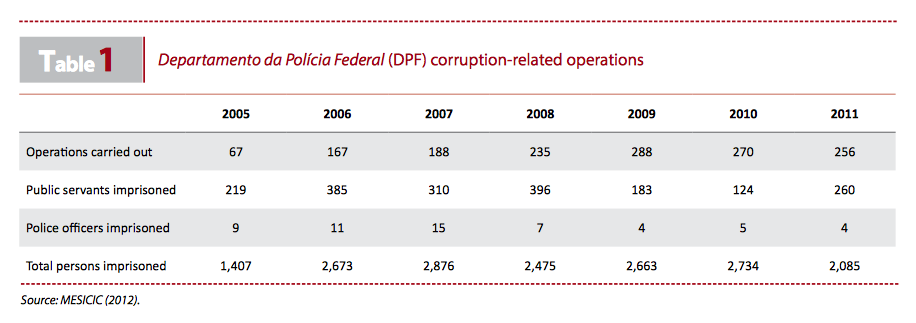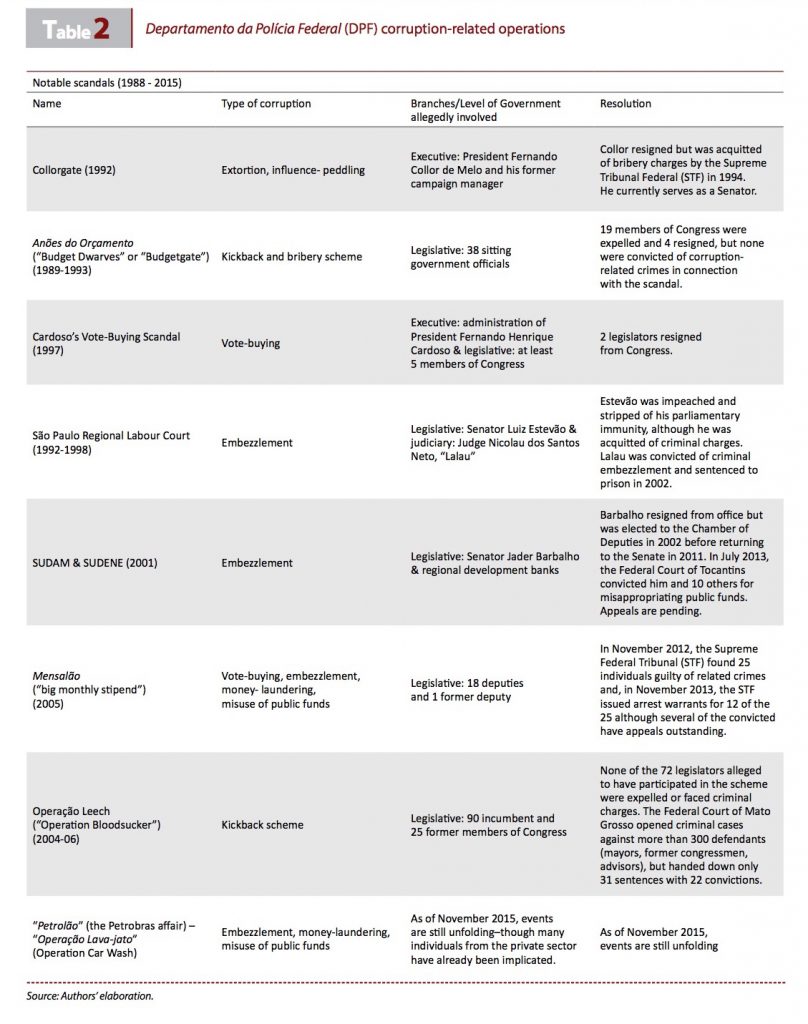This overview was based on the journal article ‘Using institutional multiplicity to address corruption as a collective action problem: Lessons from the Brazilian case‘, by Lindsey Carson and Mariana Prado.
Anti-corruption mechanisms in Brazil
At the core of any effective strategy to combat corruption lies a strong system of accountability to discover and sanction those who participate in corrupt activities. Accountability institutions perform three primary functions: oversight, investigation and punishment.
These functions are highly interdependent. Indeed, the completion of each one of the steps in the accountability process is largely dependent on the preceding and successive steps. Thus, without oversight there is no investigation, and without investigation there can be no effective punishment. Interdependence goes in the other direction as well: if punishment is unlikely to happen, this reduces incentives for effective oversight and investigation.
The lesson from the Brazilian case concerns the potential advantages of having multiple institutions able to perform the same function within the accountability system.
Figure 1 illustrates this. If one of the regular avenues for performing one of these functions is blocked, the interested actors can pursue alternative avenues. This increases the likelihood that there will be accountability in one form or another at the end of the process.
Moreover, institutional multiplicity can generate institutional improvements within the system by triggering processes and mechanisms that improve the overall performance of the system in at least four ways:
- Competition can drive institutions to improve their performance in light of results or outcomes delivered by another institution performing a similar function.
- Compensation may also be a result of multiplicity. If one of the institutions fails to perform its functions, another is equipped to fill the resulting gap. This could reduce the risk of failure in each step of the accountability process.
- Collaboration between organisations may be advantageous simply because there are more human, financial and other resources available for the performance of a single task.
- Complementarity may be especially advantageous due to specialisation (two different institutions may contribute different complementary skills to perform a particular task).
Corruption in Brazil: an overview
Over the past few decades, the fight against corruption has emerged as a top priority on the global development agenda, as leaders in policy, academic, NGO and business communities around the world have recognised corruption as a force that undermines economic expansion and equality, accountable and transparent governance and social cohesion.
Characterised by strong economic growth and political stability over the past few decades, Brazil has taken steps to address corruption, but the persistence of the problem in the country’s economic and governance systems has not been without cost. Recent studies estimate that corruption consumes between 1.4 per cent (FIESP 2010) and 5 per cent of the country’s gross domestic product (GDP) each year, and surveys reveal that a large majority of the Brazilian public has little trust or confidence in the government.
International surveys regarding perceptions of corruption show that Brazil is ranked around the median among all countries, as well as in comparison with its regional peers; it also outperforms the other BRICS countries (see Figures 2 and 3). However, while the country boasts an impressively comprehensive array of anti-corruption laws, Brazil’s corruption scores have remained relatively stable over the past two decades. Moreover, numerous scandals at the federal, state and municipal levels and across all branches of government—most recently the Mensalão and Petrolão cases, as well as allegations surrounding the cost overruns associated with the World Cup preparations—confirm that corruption remains entrenched in the country’s political system.
The performance of Brazil’s accountability system
Oversight: At the federal level, oversight is primarily managed by two institutions—the Federal Accounting Tribunal (Tribunal de Contas da União, TCU) and the Office of the Comptroller General of the Union (Controladoria-Geral da União, CGU).
While both institutions occasionally communicate on cases, they generally conduct their oversight activities autonomously, an arrangement which appears to have provided beneficial safeguards in at least one case. After the auditing processes of the TCU failed to detect a municipal ambulance kickback scheme, the CGU uncovered the scandal through its own monitoring process in an operation that became known as ‘Operation Leech’ (Operação Sanguessuga).
The ‘leech’ scandal may be an example of institutional compensation or complementarity. Some may argue that the TCU’s failure to detect the scheme reflects deficiencies in its auditing process (which is perceived to be formalistic and ossified), while the CGU’s success in identifying the irregularities indicates that their auditing methods are more effective. If so, this would be a case of compensation.
On the other hand, one may claim that this is simply a result of distinct auditing methods. The monitoring techniques of the CGU were specifically designed to use different parameters than those used by the TCU, to increase the likelihood of each institution catching things undetected by the other. This is a case of complementarity.
Regardless of whether it is compensation or complementarity, this example illustrates how overlapping oversight functions may increase the chances of spotting wrongdoing.
Investigation: The central institutions performing investigative functions at the federal level in Brazil are the Federal Public Prosecutors’ Office (Ministério Público Federal, MPF) and the Federal Police (Departamento da Polícia Federal, DPF).
Often the MPF will conduct criminal investigations in collaboration with the DFP, especially in criminal cases. Indeed, there has been an increase in the number of investigations in the last decade (see Table 1), which appears to be the result not only of an increase in resources for DPF but also increased cooperation between DPF, MPF and other investigative bodies, such as state public prosecutors’ offices, revenue service inspectors and ministries. In many cases, joint task forces have been formed to better coordinate investigations. The results appear positive, suggesting that institutional multiplicity has led to collaboration.
Despite being the exception rather than the rule, in a few cases the investigative powers of MPF seem to have led to compensation for the lack of police action. The cases in which MPF played a prominent role include the recent mensalão case.
Punishment: The most important institution involved in the punishment of corruption-related offences is the federal judiciary, through civil and criminal lawsuits. Recently administrative sanctions have gained a greater importance in the country.
The level of institutional multiplicity in punishment in Brazil is considerably lower than in oversight and investigation. Independently of the civil and criminal sanctions imposed by the judiciary, the CGU, TCU and internal accountability bodies can impose administrative sanctions on actors found to have engaged in corrupt activities.
However, the ultimate sanctioning authority in Brazil remains the judiciary, which holds the power to review and overturn punishments imposed by other entities (CF 88 art. 5, XXXV).
This lack of institutional multiplicity reduces the likelihood of punishment. Indeed, the Brazilian judiciary is characterised by very low rates of corruption convictions. Such underperformance is attributable not to sporadic errors in execution but, rather, to fundamental structural problems such as excessively formalistic processes, burdensome procedural rules and judicial corruption. These problems not only affect the enforcement of civil and criminal sanctions but also interfere with the enforcement of administrative sanctions.
Disadvantages of institutional multiplicity
The Brazilian case suggests that significant benefits can be derived from having institutional multiplicity in a country’s accountability system. There are, however, potential disadvantages associated with institutional multiplicity:
- Inefficiency: The creation of institutional overlaps may be interpreted as an inefficient allocation of resources, particularly in low-income developing countries where scarce fiscal resources already struggle to provide adequate coverage for other societal needs, such as education and health.
- Destructive competition: The competition engendered through institutional multiplicity may create unproductive tensions between two institutions performing the same function, undermining their ability to effectively perform their functions.
- More Corruption: If accountability institutions themselves fall prey to corruption, institutional multiplicity may create more opportunities for corruption; for example, if authorities from multiple (corrupt) investigation institutions are able to extract bribes by threatening innocent citizens with false charges, the overall risk and incidence of corruption may increase.
We acknowledge these limitations, which should be considered in a careful cost–benefit analysis on a case-by-case basis, taking into consideration the resources, capacities and policy needs within individual countries or societies.
___________________________
References
Brazil. 1988. Constitution of the Federative Republic of Brazil. Art. 5, XXXV. Brasilia: Brazil.
FIESP. 2010. Relatório Corrupção: custos econômicos e propostas de combate.
São Paulo: Federação das Indústrias do Estado de São Paulo. Accessed 13 November 2015.
MESICIC. 2012. Federative Republic of Brazil Final Report. Washington, DC: Mechanism for Follow-up on the Implementation of the Inter-American Convention against Corruption.
Prado, Mariana Mota, and Lindsey Carson. 2014a. ‘Mapping Corruption and its Institutional Determinants in Brazil‘. IRIBA Working Paper, No. 8. Manchester: International Research Initiative on Brazil and Africa. Accessed 13 November 2015.
Prado, Mariana Mota, and Lindsey Carson. 2014b. ‘Mapping Corruption and its Institutional Determinants in Brazil‘. IRIBA Working Paper, No. 9. Manchester: International Research Initiative on Brazil and Africa. Accessed 13 November 2015.
Transparency International. 2013a. Corruption Perceptions Index. Berlin: Transparency International.
World Bank. 2012. ‘Worldwide Governance Indicators‘. Accessed 13 November 2015.
